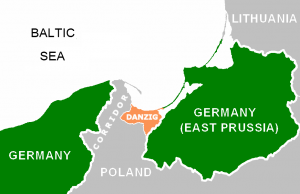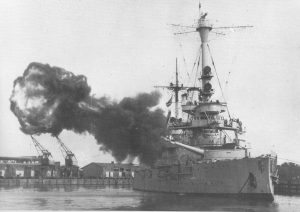- Author
- A.N. Other
- Subjects
- Ship histories and stories, History - WW2
- Tags
-
- RAN Ships
- None noted.
- Publication
- June 2017 edition of the Naval Historical Review (all rights reserved)
By Walter Burroughs
In September 2016 the author was a passenger on a cruise ship which berthed at the Baltic port of Gdansk in almost the same position as a German battleship had seventy-seven years earlier – a warship that fired the first shots signifying the start of the Second World War. On a green mound above the berth and once the site of a fort shelled by the battleship now stands a poignant monument to the wartime sacrifices of the Polish people.
As dawn broke on the first day of September 1939 German forces began an assault on Poland which culminated a little over a month later in the total subversion of that country. Germany having failed to respond to requests to withdraw its forces, Britain and France coming to the aid of their Polish ally, declared war upon Germany.
In Australia two days later, on a quiet Sunday morning, Prime Minister Robert Menzies broadcast to the nation choosing the following words: Fellow Australians, it is my melancholy duty to inform you officially, that in consequence of persistence by Germany in her invasion of Poland, Great Britain has declared war upon her and that, as a result, Australia is also at war.Thus began our nation’s involvement in what would become the deadliest conflict in known history. But how did it all start?
Poland has had a tumultuous history with its fertile plains subject to many invasions and border disputes. As its national boundaries changed many times it is ethnically diverse with a population mainly of Polish, German and Russian origins.

In more recent times dramatic changes occurred following the First World War when, subject to the Treaty of Versailles, previous German held West Prussia largely became part of Poland and was separated from East Prussia (still retained by Germany) by a land corridor controlled by Poland. At the same time, between West and East Prussia the Free City of Danzig (later named Gdansk) was created, with the region remaining separate from Germany and Poland and under League of Nations protection. The Free City was however created to give Poland access to a major seaport and in administrative terms it came under their control.
This situation was an obvious affront to Germans and propaganda being fomented by them in the late 1930s for the freedom and unification of German peoples inflamed resentment. In 1938 Germany was able to stare down British and French opposition to ‘liberate’ its subjects from Sudetenland in Czechoslovakia, and it was then only a matter of time before attention turned to Poland with its significant German speaking population.
In the immediate lead-up to this conflict, German forces now on a war footing were strategically placed within striking distance of its Polish frontier. Being aware of warmongering, Poland began a partial mobilisation of its forces. On 25 August 1939 the German battleship Schleswig-Holstein, commanded by Kapitan zur See Gustav Kleikamp, made a good-will visit to Danzig ostensibly honouring the memory of the crew of the German cruiser Magdeburg(1)which had been sunk 25 years earlier and whose dead were buried in the city. Thousands of Danzigers waved in welcome to the ship as cadets lined her decks in salute before mooring under Polish fortifications at Westerplatte. Unseen below her decks were 300 hundred heavily armed assault troops.
Schleswig-Holstein
Launched in 1906 the 13,200 ton Schleswig-Holstein(2) was the last pre-dreadnought battleship to enter the German Navy. During WWI she saw service in the North Sea and was at the Battle of Jutland where she was damaged by enemy shell fire. Owing to her obsolescence she was one of the few major warships permitted to be retained by Germany under the terms of the Treaty of Versailles. In 1935 she was converted to a training ship for naval cadets and her main armament reduced to 4 x 11-inch and 10 x 6-inch guns supported by a smaller number of anti-aircraft weapons.

In the early hours of 01 September 1939 the battleship silently slipped her moorings and glided down stream to anchor within clear view of the Polish fort. At 04:47 when the first glimmer of daylight was observed she unleashed a bombardment upon the fort at almost point blank range. This was the signal for German forces to commence their invasion, giving rise to a new ferocious form of warfare known as ‘Blitzkrieg’ or Lightning Strike. Almost at once squadrons of Luftwaffe bombers attacked Polish airfields aiming for the destruction of aircraft before they could disperse. Next, German troops led by Panzer divisions crossed the border; other than speed their greatest asset was radio communications, allowing them to be effectively controlled.
While forbidden under treaty obligations, Polish forces had secretly reinforced the casements at Westerplatte. The fort was well defended and despite overwhelming odds from the assault troops, and an attack by Stuka dive bombers, the small Polish garrison held out for seven days. The victors were impressed by the determination of the defenders and in these early days of the war after surrender, the 200 garrison troops under command of Major Henryk Sucharaki were treated with great respect. The Polish Navy dispersed its forces to sea before they were smothered by German sea and air attacks. After dramatic escapes two of her five submarines and three of her four destroyers reached Britain. The other submarines were interned in neutral Sweden and one destroyer, in dockyard hands, was unable to leave.
Under secret protocols known as the ‘Molotov-Ribbentrop Pact’ the Soviet Union on 17 September 1939 thrust its forces along an extensive western border into beleaguered Poland, thereby sealing its fate and dividing the spoils with Germany. The war, although one sided, was not without cost. Polish casualties amounted to 66,300 dead, 133,700 wounded; 587,000 prisoners were captured by Germany and another 100,000 by the Soviet Union. Russian casualties were nominal while Germany lost 16,000 dead and 32,000 wounded. However, a total of 200,000 Polish servicemen fought in the Second World War under British command. Most important were its pilots who manned some of the RAF Fighter Command’s most successful squadrons during the Battle of Britain. Some have postulated that without the support of Polish airmen the battle could have been lost, leaving the country exposed to planned invasion.
War Ends and a New Beginning
The ship that started the war came to an ignoble end. The elderly Schleswig-Holstein was bombed and sunk by British aircraft in December 1944. She was subsequently salvaged and then beached being used as a target by the Soviet Navy.
The grand medieval Hanseatic city of Danzig (Gdansk) was extensively damaged during its ‘liberation’ towards the end of WWII. Gdansk was to claim fame as the home of Lech Walesa, the Polish shipyard worker and patriot who in 1980 co-founded the ‘Solidarity Movement’. The advent of ‘Solidarity’ confronted Soviet occupation of territories in Eastern Europe eventually leading to their return to democratic government with Walesa awarded the Nobel Peace Prize as President of the Polish Republic. In 2016 a frail Lech Walesa still resides in his beloved Gdansk.
Notes:
- SMS Magdeburg was a new light cruiser which early in WWI formed part of a squadron sent into the Baltic to bombard Russian positions. On 26 August 1914 while off the coast of Estonia she ran aground and as she could not be freed the decision was made to scuttle the ship and transfer her crew to an accompanying destroyer. While this was taking place she was discovered by two Russian cruisers who shelled the hapless ship when 15 German sailors were killed. On boarding the ship the Russians were able to salvage three German Naval code books which were in the process of being destroyed. One of these was passed to British authorities. Winston Churchill, then First Lord of the Admiralty, called this a priceless document used to great advantage in predicting the movement of German ships including at the Battle of Jutland.
2.SMS Schleswig-Holstein was later berthed at the nearby German occupied port of Gdynia where she was attacked by RAF aircraft in December 1944 when 28 of her crew were killed. She was again attacked by RAF aircraft in March 1945 after which the burning ship was scuttled near the port. The ship was subsequently salvaged and then beached for use as a target by the Soviet Navy. Vizeadmiral Kleikamp was captured by British forces in May 1945 and served two years as a POW, he died in September 1952.




